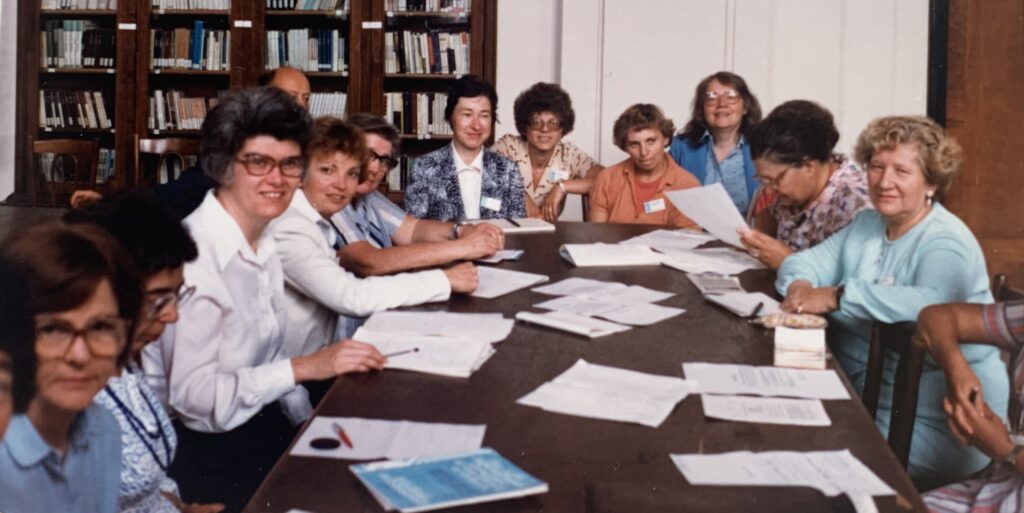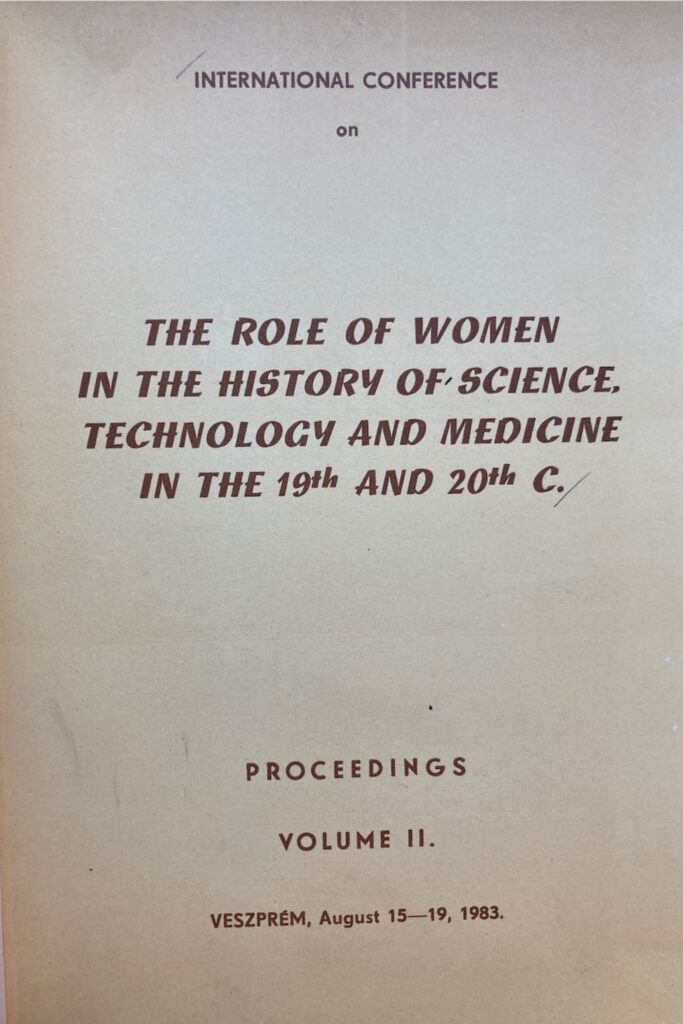In memoriam: Margaret Walsh Rossiter (1944-2025), Commission co-founder and first president
With the death of Margaret Walsh Rossiter on August 3, 2025, the Commission lost its co-founder and inaugural president, and the history of science lost a preeminent historian of women in American science. Throughout a career spanning over fifty years, Rossiter “persisted despite a lot of discouragement” in successfully “broadening and remaking the field,” to embrace new and formerly “controversial” subjects of women and gender. She did this through her pathbreaking scholarship and, as importantly, her indefatigable work to warm up a chilly professional climate for women historians. The international Commission on Women and Gender in the History of Science, Technology, and Medicine is an outcome of Rossiter’s efforts in this regard.
Photograph of founding members of the Commission at a meeting held during the XVIth International Congress held in Bucharest, Romania, in 1981. Margaret W. Rossiter, first president, is seated third from left. Courtesy of Pnina Abir-Am.

Margaret Rossiter was born on July 8, 1944, in Malden, Massachusetts, to Mary Julia Rossiter (née Madden, 1914–2005), and Charles Aston Rossiter (1911–1986), a U.S. Army officer. Her parents attended Radcliffe and Harvard colleges, respectively, both graduating in 1934. During her father’s military service, Margaret Rossiter and her twin brother, Charles Aston Rossiter, Jr. (who predeceased her in 2004), lived with their parents in government-sponsored housing for married officers nearby army bases. After the conclusion of World War II and their father’s discharge, the family lived in Malden where Charles Aston, Sr. taught high-school history.
In 1951 Margaret Rossiter’s family moved to nearby Melrose, where she attended high school. Distinguishing herself as a National Merit Scholar, she entered her mother’s alma mater, Radcliffe College, in 1962 to major in mathematics, but she soon switched to chemistry, and then ultimately to the history of science, an interest she had cultivated alongside her high school studies. After graduating from Radcliffe she pursued graduate studies, ultimately earning her PhD in the history of science at Yale in 1971, under the supervision of Frederic Lawrence Holmes. She published her dissertation in 1975: The Emergence of Agricultural Science, Justus Liebig and the Americans, 1840–1880. Her focus on a physical science, agricultural chemistry, reflected an emphasis both of her education and of the young history of science when she entered the field in the 1960s.
Curious about the prevalence of women scientists historically, and despite being told by senior (men) colleagues that none existed apart from Marie Curie, Rossiter nevertheless noticed several, typically brief, biographies of women in James McKeen Cattell’s American Men of Science (1906). Such discoveries inspired her first paper on the subject, published in American Scientist in 1974, and she promptly received over 200 requests for reprints from interested readers who reported further cases of notable women scientists. The interest propelled Rossiter to continue her research on the topic. Over the ensuing decade her source materials—many discovered serendipitously—“ballooned out of control,” compelling her to write three full volumes, published by Johns Hopkins University Press as the series, Women Scientists in America (1982, 1995, 2012).
For scholars everywhere Rossiter’s books laid the bedrock for comprehensive, gendered studies of the history of women scientists within national contexts. She modeled this by mining untapped manuscript and oral sources; by reinterpreting standard reference works ostensibly about “men of science” but in which women were very much present; and by charting the structural patterns that differentiated the career trajectories of women and men. By charting and coining the predominant patterns familiar to many in the field today—“hierarchical” and “territorial segregation,” “women’s work” (in science), “the Madame Curie strategy” (or deliberate overqualification to compete for positions “sex-typed” as “men’s work”), and, most famously, “the Matilda effect” (the ubiquitous discrediting of women’s contributions alongside men’s)—Rossiter demonstrated how gender-attentive concepts and vocabularies could underpin and propel a new subfield. Her works inspired robust historical agendas on scientific couples, scientific families and households, feminized disciplines like home economics, women’s “subcultures,” and the impact of professionalization and institutionalization on gender stratification (through such policies like anti-nepotism rules). She noted that her foreign colleagues were “deploring the lack of similar volumes for their own countries,” but indeed a range of books—especially edited collections—came forth from many countries in the ensuing decades.
For the emerging generations of historians interested in women and gender in science, critical to their successes have been the “spaces” that Rossiter co-created to sustain networks and venues so vital to the new, “controversial” subjects. She was an early participant and founding member of key groups that advocated for opening the historical professions to women’s and gender studies, particularly the Women’s Caucus of the History of Science Society, formed in 1972, and the international Commission on Women in the History of Science, Technology, and Medicine, as it was first named when established in 1981.
As Rossiter later noted, a catalyst for the idea of the Commission was her 1980 article on “‘Women’s Work’ in Science, 1880–1910,” published in Isis with an accompanying cover illustration depicting women scientists. This attracted “worldwide attention to the political acceptance of the topic,” soon manifested in a three-day symposium on women in science at the XVIth International Congress of the History of Science held in Bucharest, Romania, in 1981. Thanks to Rossiter’s organizing effort, twenty-nine papers from twelve countries populated the symposium, one of the largest of the congress. With symposium participants supporting the effort, Rossiter co-drafted, with colleague Sally Gregory Kohlstedt, the proposal for establishing the Commission as an official member of the Division of History of Science (afterwards “and Technology”), the parent sponsor of the congress. Despite the contentiousness generated by the proposal among certain voting delegates, it won majority support of the General Assembly and Rossiter was named first president. She served in the role for the next eight years. Since then, she remained an active member of the Commission.
Many in the Commission have personal stories about how Rossiter positively influenced their careers through her writings, mentorship, and collegiality, especially during meetings and workshops of the Commission. She remained a thought leader and wise counselor to successive generations of officers. She once expressed (in 2002) whether her foundational scholarship was “opening up a new area for further work,” or “exhausting a thin terrain so totally that other scholars will be discouraged for decades to come.” But in noting the arrival of a robust, growing literature on women in science, and observing colleagues in other countries pushing for further national studies, she felt encouraged that her work proved inspiring, not discouraging.
In remembering what Rossiter did for the Commission, it is essential to take stock of her extensive and generous service to the profession at large. Encouraged by her Women’s Caucus colleagues, she applied for and was selected to edit Isis, serving as the journal’s first woman editor (1994 through 2003). She supported the endowment of the History of Science Society’s “Women’s Prize,” renamed for her in 2004 as the Margaret W. Rossiter History of Women in Science Prize. In 2022 the Society presented her with its most prestigious award, the George Sarton Medal, in recognition of her distinguished, lifetime scholarly achievement.
Rossiter did much of what she accomplished in the field—up until 1990—without the stability of a tenured academic position, but instead with support secured through a string of grants, fellowships, and temporary positions. But as she recollected, a phone call she received in July 1989 “changed my career”—the caller being the John D. and Catherine T. MacArthur Foundation, who selected her to receive one of its “genius” grants. The award’s prestige and the advocacy of her supporters compelled Cornell University, where she held a contingent position, to appoint her to a permanently endowed professorship, the Marie Underhill Noll Professor of History of Science, in the newly-created Department of Science and Technology Studies. She held the position until her retirement in 2023. In addition to her MacArthur Fellowship, other honors included a Guggenheim Fellowship (1981), the Berkshire Prize (1983, for the first volume of Women Scientists in America), the Women’s Prize and Pfizer Award of the History of Science Society (1997, for the same title’s second volume), and fellowship in the Agricultural History Society (2007) and the American Association for the Advancement of Science (2013).
When the Commission marked its 40th anniversary in 2022, with some reluctance Rossiter consented to offering her hindsight view, despite preferring to urge the group forward: “I agree a retelling of our history might be uplifting, but getting on with future plans is probably a better use of the group’s time.” In this spirit, the Commission pauses here to remember a dear, late colleague and mentor, and the bedrock she laid, for the benefit of the wider community. But now we resume “getting on with future plans,” as Rossiter called upon us to do.
Donald L. Opitz
References
This tribute draws on the following works: Donald L. Opitz, “In Memoriam: Margaret Walsh Rossiter, Pathbreaker in “Writing Women into Science,” AIP History Newsletter (October 24, 2025); Margaret W. Rossiter, “Writing Women into Science,” in Jonathan Monroe, ed., Writing and Revising the Disciplines (Ithaca: Cornell University Press, 2002), pp. 54–72 (source for most of the quotes); Rossiter, “Women Scientists in America before 1920,” American Scientist 62 (1974): 312–23; Rossiter, “‘Women’s Work’ in Science, 1880–1910,” Isis 71 (1980): 381–98; Rossiter, Women Scientists in America: Struggles and Strategies to 1940 (Baltimore: Johns Hopkins University Press, 1982); Rossiter, “New Commission on the History of Women in Science, Technology, and Medicine,” Science, Technology, & Human Values 7, no. 3 (1982): 116; Rossiter, “Opening Remark,” in International Conference on the Role of Women in the History of Science, Technology, and Medicine in the 19th and 20th C.: Proceedings, Veszprém, August 15–19, 1983, 2 vols. (Budapest: MTESZ, 1984), II: ix–xi; Rossiter, “The Matthew Matilda Effect in Science,” Social Studies of Science 23 (1993): 425–41; Rossiter, email to Donald L. Opitz, July 6, 2022; Wikipedia Contributors, “Margaret W. Rossiter,” Wikipedia, The Free Encyclopedia (accessed October 14, 2025). The papers of Margaret W. Rossiter are held at the Schlesinger Library, Harvard Radcliffe Institute.
Rossiter’s remarks on the Commission (1983)
In 1983, during the conference at Veszprém, historian of science Margaret W. Rossiter delivered this foundational statement marking the creation of the Commission on Women and Gender in the History of Science, Technology, and Medicine. Her remarks capture the intellectual and institutional motivations behind the Commission’s formation and its commitment to advancing research on women’s roles and gender perspectives within the history of science. The complete text of Rossiter’s opening remarks is available below:
